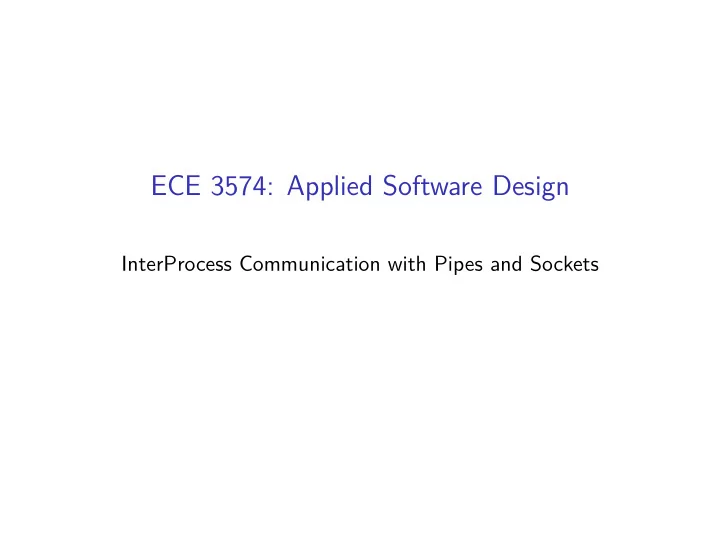

ECE 3574: Applied Software Design InterProcess Communication with Pipes and Sockets
Today we are going to look at concurrent programming using multiple OS processes. ◮ communicating processes ◮ Unix and Windows pipes ◮ Unix fork + pipes ◮ Cross-platform IPC using QProcess and QLocalSocket
A reoccuring theme in concurrent programming is the idea of communication over a channel. Depending on how these are implemented they go by many names: ◮ Pipes ◮ Sockets ◮ Message Queues ◮ Channels ◮ Signals The idea is simple. +------------------+ process 1 writes ->| |-> process 2 reads +------------------+
Communication may be half-duplex or full-duplex Half-Duplex +------------------+ process 1 writes ->| |-> process 2 reads +------------------+ Full-Duplex +------------------+ writes ->| |-> reads +------------------+ process 1 process 2 +------------------+ reads <-| |<- writes +------------------+
The message sent over the channel can take various forms ◮ the message may be just text ◮ the message might be a binary stream (exchange serialized objects) ◮ the message might be a function to call (Remote Proceedure Call) We will focus on simple messages for now and look at data serialization later.
The exact semantics of these communciation channels varies by platform Examples on Unix: ◮ Pipes (Anonymous and Named) ◮ Sockets ◮ Message Queues Examples on Windows: ◮ Pipes (Anonymous and Named) ◮ Sockets ◮ COM
A central tenant of Unix systems is that programs should be small and composable. The primary way this is done is using Pipes. Example: search through all my CMake based projects looking for ones that expect a test to fail. find ~ -name CMakeLists.txt -print | xargs grep WILL_FAIL The | character is a pipe. It connects the standard output of one program to the standard input of the next, forming a simple half-duplex channel. +--------------+ find stdout ->| |-> stdin of xargs +--------------+
Example: Unix Pipes ◮ #include <unistd.h> ◮ create a pipe with pipe giving two integer file descriptors ◮ read from one, write to the other See example code.
That’s dumb, what is that good for? We combine that with fork , which makes a copy of the current process, called the child . The parent and child process communicate over shared pipe descriptors. See example code.
A cross-platform solution using Qt The process on Unix using sockets is similar to pipes. Both have rough equivalents on Windows. Lets use Qt to do it cross-platform
QProcess ◮ QProcess is a Qt class that abstracts a process. You can start them, hijack stdin and stdout, and get their exit status. See example code ◮ QLocalSocket is a class the abstracts a local socket. On Windows this is a named pipe and on Unix this is a local domain socket, but it does not matter to us. The idea is to use QProcess similar to fork and use QLocalSocket to setup the communication. See example code.
Case Study: Message Passing Interface (MPI) High-Performance Computing is all about leveraging multiple processing units, be they cores, CPUs, or multiple machines. One approach uses seperate processes that communicate over sockets by passing messages. This is standardized as MPI (there are a few different implementations).
Next Actions and Reminders ◮ Read about Qt shared memory
Recommend
More recommend